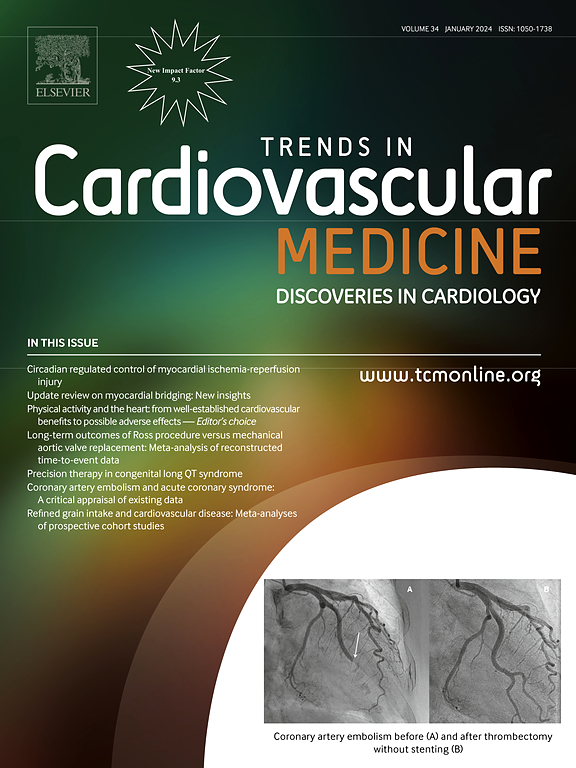Invasive management of unroofed coronary sinus: A systematic review
IF 9
2区 医学
Q1 CARDIAC & CARDIOVASCULAR SYSTEMS
引用次数: 0
Abstract
Unroofed coronary sinus (UCS) is a rare congenital anomaly, constituting under 1 % of atrial septal defects. Caused by partial or complete deficiency of the coronary sinus roof, UCS is often difficult to diagnose. While surgery remains the standard treatment, transcatheter approaches are emerging. We conducted a systematic review to evaluate outcomes of surgical and transcatheter approaches to UCS repair. Studies from MEDLINE, Embase, SCOPUS, and Web of Science were screened and selected based on predefined criteria. We extracted data on patient demographics, operative techniques, associated defects, and outcomes. Thirteen studies involving 293 patients with UCS were included. Majority (66.4 %) were male, with a mean age of 17.5 ± 11.5 years. UCS type 1A, marked by the presence of a persistent left superior vena cava and absent coronary sinus, was the most common subtype (50.4 %). Surgical repair was performed in 95.2 % of patients, with intracardiac baffle (34.1 %) and patch repair (21.9 %) being the predominant techniques. The remaining 4.8 % of patients underwent transcatheter repair, typically using Amplatzer® Septal Occluder device, with no reported procedural complications. In-hospital mortality rate was 2.7 %, and 30-day mortality was 3.0 %. Postoperative complications were rare, including residual defects (0.42 %), atrial fibrillation (2.9 %), and complete heart block requiring pacemaker (1.2 %). There were no cases of ischemic stroke. Surgical repair of UCS is associated with low postoperative mortality and complication rates, affirming its status as the standard of care. Transcatheter techniques may be feasible for select patients, though further studies are needed to to assess long-term outcomes and optimize criteria for patient selection.
无顶冠状窦的侵入治疗:系统回顾。
无顶冠状窦(UCS)是一种罕见的先天性异常,占房间隔缺陷的1%以下。由于冠状窦顶部分或完全缺失,冠状窦间性硬化通常难以诊断。虽然手术仍然是标准的治疗方法,但经导管方法正在出现。我们进行了一项系统的综述来评估手术和经导管入路修复UCS的结果。来自MEDLINE, Embase, SCOPUS和Web of Science的研究根据预定义的标准进行筛选和选择。我们提取了患者人口统计学、手术技术、相关缺陷和结果的数据。纳入了13项研究,涉及293例UCS患者。男性居多(66.4%),平均年龄17.5±11.5岁。UCS 1A型是最常见的亚型(50.4%),其特征是存在持续的左上腔静脉和没有冠状窦。95.2%的患者接受手术治疗,其中以心内折流板(34.1%)和补片修复(21.9%)为主要技术。其余4.8%的患者接受了经导管修复,通常使用Amplatzer®鼻中隔闭塞器,无手术并发症报告。住院死亡率为2.7%,30天死亡率为3.0%。术后并发症很少,包括残留缺损(0.42%)、心房颤动(2.9%)和需要起搏器的完全心脏传导阻滞(1.2%)。无缺血性脑卒中病例。手术修复UCS具有较低的术后死亡率和并发症发生率,证实了其作为标准治疗的地位。虽然需要进一步的研究来评估长期结果和完善患者选择标准,但经导管技术对某些患者可能是可行的。
本文章由计算机程序翻译,如有差异,请以英文原文为准。
求助全文
约1分钟内获得全文
求助全文
来源期刊

Trends in Cardiovascular Medicine
医学-心血管系统
CiteScore
18.70
自引率
2.20%
发文量
143
审稿时长
21 days
期刊介绍:
Trends in Cardiovascular Medicine delivers comprehensive, state-of-the-art reviews of scientific advancements in cardiovascular medicine, penned and scrutinized by internationally renowned experts. The articles provide authoritative insights into various topics, encompassing basic mechanisms, diagnosis, treatment, and prognosis of heart and blood vessel disorders, catering to clinicians and basic scientists alike. The journal covers a wide spectrum of cardiology, offering profound insights into aspects ranging from arrhythmias to vasculopathies.
 求助内容:
求助内容: 应助结果提醒方式:
应助结果提醒方式:


